Deck 3: Egypt From Narmer to Cleopatra
Question
Question
Question
Question
Question
Question
Question
Question
Question
Question
Question
Question
Question
Question
Question
Question
Question
Question
Question
Question
Question
Question
Question
Question
Question
Question
Question
Question
Question
Question
Question
Question
Question
Question
Question
Question
Question
Question
Question
Question
Question
Question
Question
Question
Question
Question
Question
Question
Question
Question

Unlock Deck
Sign up to unlock the cards in this deck!
Unlock Deck
Unlock Deck
1/50
Play
Full screen (f)
Deck 3: Egypt From Narmer to Cleopatra
1
Which of the following provides the best evidence for the daily life of ancient Egyptian society?
A) Papyrus scrolls
B) Tomb decoration
C) Portraits
D) Stone sculpture
A) Papyrus scrolls
B) Tomb decoration
C) Portraits
D) Stone sculpture
B
2
What is the most likely explanation for the portrayal of Akhenaton's body type?
A) He was misshapen after being cursed by the priests of Amen.
B) He was unable to hire artists skilled in traditional sculpture.
C) He wanted to more closely align himself with a fertility cult.
D) It was a deliberate artistic reaction against the established style.
A) He was misshapen after being cursed by the priests of Amen.
B) He was unable to hire artists skilled in traditional sculpture.
C) He wanted to more closely align himself with a fertility cult.
D) It was a deliberate artistic reaction against the established style.
D
3
Pyramids were the most common royal tombs during which period?
A) Early Dynastic period
B) Old Kingdom
C) Middle Kingdom
D) New Kingdom
A) Early Dynastic period
B) Old Kingdom
C) Middle Kingdom
D) New Kingdom
B
4
Which motif on the palette of King Narmer symbolized the superhuman strength of the god-king?
A) The entwined necks of the two animals
B) The god-king slaying his captive enemy
C) The bull knocking down fortress walls
D) Man-headed hieroglyph with papyrus plants
A) The entwined necks of the two animals
B) The god-king slaying his captive enemy
C) The bull knocking down fortress walls
D) Man-headed hieroglyph with papyrus plants

Unlock Deck
Unlock for access to all 50 flashcards in this deck.
Unlock Deck
k this deck
5
The false doors in mastaba tombs were meant to give access to whom?
A) Visiting relatives
B) The ben-ben
C) The ka
D) Cemetery custodians
A) Visiting relatives
B) The ben-ben
C) The ka
D) Cemetery custodians

Unlock Deck
Unlock for access to all 50 flashcards in this deck.
Unlock Deck
k this deck
6
What is the shape of the column capitals in the hypostyle hall at Karnak?
A) Lions
B) Rhinoceros
C) Lotus or papyrus plants
D) Curved volutes
A) Lions
B) Rhinoceros
C) Lotus or papyrus plants
D) Curved volutes

Unlock Deck
Unlock for access to all 50 flashcards in this deck.
Unlock Deck
k this deck
7
Which of the following is a drawback of the fresco secco technique?
A) Application of paint must be done quickly.
B) Multiple artists cannot work in the small space.
C) Colors do not fuse to the wall surface.
D) The necessary materials were difficult to acquire.
A) Application of paint must be done quickly.
B) Multiple artists cannot work in the small space.
C) Colors do not fuse to the wall surface.
D) The necessary materials were difficult to acquire.

Unlock Deck
Unlock for access to all 50 flashcards in this deck.
Unlock Deck
k this deck
8
Which site has yielded significant evidence for Predynastic art?
A) Thebes
B) Gizeh
C) Alexandria
D) Hierakonopolis
A) Thebes
B) Gizeh
C) Alexandria
D) Hierakonopolis

Unlock Deck
Unlock for access to all 50 flashcards in this deck.
Unlock Deck
k this deck
9
What metaphor is embodied in the hunting scenes in tomb interiors, aside from providing nourishment for the ka?
A) The triumph of the gods
B) The triumph over evil
C) The triumph of the judged soul
D) The triumph of light over darkness
A) The triumph of the gods
B) The triumph over evil
C) The triumph of the judged soul
D) The triumph of light over darkness

Unlock Deck
Unlock for access to all 50 flashcards in this deck.
Unlock Deck
k this deck
10
Whose mortuary temple was moved from Abu Simbel to save it from the Aswan High Dam Reservoir?
A) Hatshepsut
B) Khafre
C) Ramses II
D) Akhenaton
A) Hatshepsut
B) Khafre
C) Ramses II
D) Akhenaton

Unlock Deck
Unlock for access to all 50 flashcards in this deck.
Unlock Deck
k this deck
11
Which terms best describe the majority of Egyptian art-with the exception of the Amarna period?
A) Fluid and experimental
B) Naturalistic and traditional
C) Conservative and fleeting
D) Conservative and formulaic
A) Fluid and experimental
B) Naturalistic and traditional
C) Conservative and fleeting
D) Conservative and formulaic

Unlock Deck
Unlock for access to all 50 flashcards in this deck.
Unlock Deck
k this deck
12
Why is the palette of King Narmer unique among surviving early dynastic artworks?
A) It names its artist and his teacher.
B) It contains a historical narrative.
C) It lists the names of the Egyptian gods.
D) It was found in the Great Pyramid.
A) It names its artist and his teacher.
B) It contains a historical narrative.
C) It lists the names of the Egyptian gods.
D) It was found in the Great Pyramid.

Unlock Deck
Unlock for access to all 50 flashcards in this deck.
Unlock Deck
k this deck
13
Aside from their funerary function, what was the intended message of the pyramids?
A) A celebration of the afterlife for elite individuals
B) Encouraging people to support the priests of Amen
C) The need to provide employment to the mason guild
D) A reminder of the absolute power of the pharaoh
A) A celebration of the afterlife for elite individuals
B) Encouraging people to support the priests of Amen
C) The need to provide employment to the mason guild
D) A reminder of the absolute power of the pharaoh

Unlock Deck
Unlock for access to all 50 flashcards in this deck.
Unlock Deck
k this deck
14
Many of the temples of the New Kingdom followed which sort of plan?
A) Asymmetrical
B) Bent access
C) Circular
D) Axial
A) Asymmetrical
B) Bent access
C) Circular
D) Axial

Unlock Deck
Unlock for access to all 50 flashcards in this deck.
Unlock Deck
k this deck
15
What substance fills most of the interior of the Great Pyramid at Gizeh?
A) Air
B) Wood
C) Sand
D) Stone
A) Air
B) Wood
C) Sand
D) Stone

Unlock Deck
Unlock for access to all 50 flashcards in this deck.
Unlock Deck
k this deck
16
Which room of the New Kingdom pylon temple at Karnak contains an example of a clerestory?
A) The forecourt
B) The inner sanctuary
C) The hypostyle hall
D) The pylon gateway
A) The forecourt
B) The inner sanctuary
C) The hypostyle hall
D) The pylon gateway

Unlock Deck
Unlock for access to all 50 flashcards in this deck.
Unlock Deck
k this deck
17
Which work likely commemorates the unification of Upper and Lower Egypt?
A) Palette of Djoser
B) Palette of Narmer
C) The Great Pyramid of Khufu
D) The stepped pyramid
A) Palette of Djoser
B) Palette of Narmer
C) The Great Pyramid of Khufu
D) The stepped pyramid

Unlock Deck
Unlock for access to all 50 flashcards in this deck.
Unlock Deck
k this deck
18
Which of the following gods appears as a falcon and is a protector of the pharaoh?
A) Thoth
B) Seth
C) Osiris
D) Horus
A) Thoth
B) Seth
C) Osiris
D) Horus

Unlock Deck
Unlock for access to all 50 flashcards in this deck.
Unlock Deck
k this deck
19
Tomb paintings were created in which of the following techniques?
A) Oils
B) Fresco secco
C) Encaustic
D) Tempera
A) Oils
B) Fresco secco
C) Encaustic
D) Tempera

Unlock Deck
Unlock for access to all 50 flashcards in this deck.
Unlock Deck
k this deck
20
What detail of the kneeling statue of Hatshepsut indicates her status as pharaoh?
A) She is kneeling in the presence of mortals.
B) She is carrying offerings to the gods.
C) She is wearing the royal headdress and kilt.
D) She holds a papyrus scroll detailing her accomplishments.
A) She is kneeling in the presence of mortals.
B) She is carrying offerings to the gods.
C) She is wearing the royal headdress and kilt.
D) She holds a papyrus scroll detailing her accomplishments.

Unlock Deck
Unlock for access to all 50 flashcards in this deck.
Unlock Deck
k this deck
21
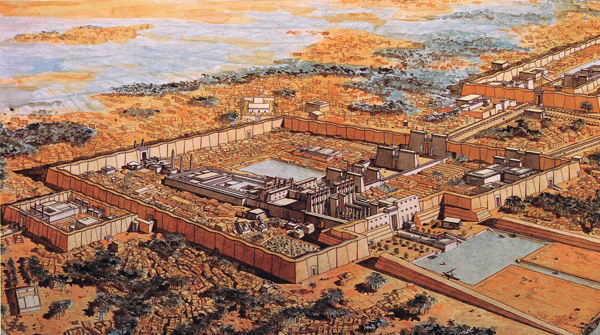
Where is the temple complex is depicted here?
A) Gizeh
B) Karnak
C) Luxor
D) Thebes

Where is the temple complex is depicted here?
A) Gizeh
B) Karnak
C) Luxor
D) Thebes

Unlock Deck
Unlock for access to all 50 flashcards in this deck.
Unlock Deck
k this deck
22
What object was discovered during Napoleon's expedition to Egypt in 1799?
A) Palette of Narmer
B) Mask of Tutankhamen
C) Rosetta Stone
D) Statue of Akhenaton
A) Palette of Narmer
B) Mask of Tutankhamen
C) Rosetta Stone
D) Statue of Akhenaton

Unlock Deck
Unlock for access to all 50 flashcards in this deck.
Unlock Deck
k this deck
23
The mortuary temple at Deir el-Bahri was built for which pharaoh?
A) Nefertiti
B) Imhotep
C) Hatshepsut
D) Sobekneferu
A) Nefertiti
B) Imhotep
C) Hatshepsut
D) Sobekneferu

Unlock Deck
Unlock for access to all 50 flashcards in this deck.
Unlock Deck
k this deck
24
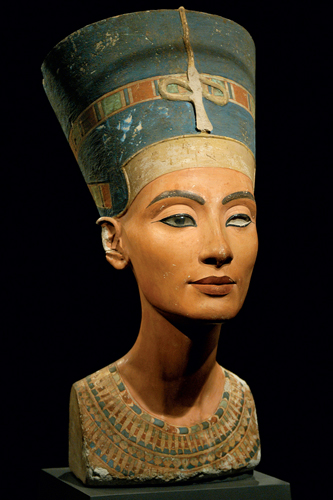
Who is the subject of this portrait?
A) Hatshepsut
B) Khamerernebty
C) Tiye
D) Nefertiti

Who is the subject of this portrait?
A) Hatshepsut
B) Khamerernebty
C) Tiye
D) Nefertiti

Unlock Deck
Unlock for access to all 50 flashcards in this deck.
Unlock Deck
k this deck
25
Which of the following plants was commonly used to symbolize Upper Egypt?
A) Papyrus
B) Lotus
C) Nettle
D) Myrtle
A) Papyrus
B) Lotus
C) Nettle
D) Myrtle

Unlock Deck
Unlock for access to all 50 flashcards in this deck.
Unlock Deck
k this deck
26
The conventions for representing the human figure that dominated Egyptian art until the end of the New Kingdom can be found in which of the following?
A) The Rosetta Stone
B) The stele of Ramses
C) The standard of Heliopolis
D) The palette of King Narmer
A) The Rosetta Stone
B) The stele of Ramses
C) The standard of Heliopolis
D) The palette of King Narmer

Unlock Deck
Unlock for access to all 50 flashcards in this deck.
Unlock Deck
k this deck
27
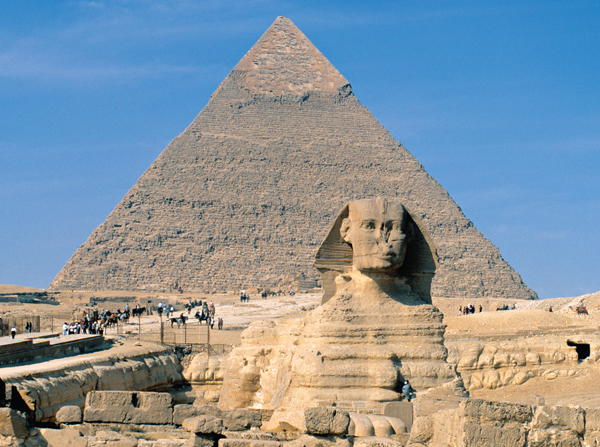
Where did the stone for this monument come from?
A) Abu Simbel
B) Thebes
C) The Gizeh plateau
D) Luxor

Where did the stone for this monument come from?
A) Abu Simbel
B) Thebes
C) The Gizeh plateau
D) Luxor

Unlock Deck
Unlock for access to all 50 flashcards in this deck.
Unlock Deck
k this deck
28
What Old Kingdom structure adjoined the pyramid and was the site of ceremonies honoring the dead king?
A) Valley temple
B) Causeway
C) Hypostyle sanctuary
D) Mortuary temple
A) Valley temple
B) Causeway
C) Hypostyle sanctuary
D) Mortuary temple

Unlock Deck
Unlock for access to all 50 flashcards in this deck.
Unlock Deck
k this deck
29

What architectural form most influenced the shape of the monument shown here?
A) Pyramid
B) Pylon
C) Causeway
D) Mastaba

What architectural form most influenced the shape of the monument shown here?
A) Pyramid
B) Pylon
C) Causeway
D) Mastaba

Unlock Deck
Unlock for access to all 50 flashcards in this deck.
Unlock Deck
k this deck
30
Which of the following describes a building technique commonly used in Egyptian temples?
A) Corbelled vaulting
B) Ashlar masonry
C) Post and lintel
D) Mudbrick and wood
A) Corbelled vaulting
B) Ashlar masonry
C) Post and lintel
D) Mudbrick and wood

Unlock Deck
Unlock for access to all 50 flashcards in this deck.
Unlock Deck
k this deck
31
What term describes the many-columned hall found in an Egyptian temple?
A) Colonnaded
B) Central
C) Hypostyle
D) Apsidal
A) Colonnaded
B) Central
C) Hypostyle
D) Apsidal

Unlock Deck
Unlock for access to all 50 flashcards in this deck.
Unlock Deck
k this deck
32
How does the Great Pyramid reflect the influence of the city of Heliopolis?
A) Heliopolis was the location of the the pharaoh Djoser's palatial complex.
B) Heliopolis was the seat of the powerful cult of Re, whose emblem was the ben-ben.
C) Heliopolis was the home of Imhotep, the architect of the Great Pyramid.
D) Heliopolis was the capital of the masons' guild that oversaw the pyramid's construction.
A) Heliopolis was the location of the the pharaoh Djoser's palatial complex.
B) Heliopolis was the seat of the powerful cult of Re, whose emblem was the ben-ben.
C) Heliopolis was the home of Imhotep, the architect of the Great Pyramid.
D) Heliopolis was the capital of the masons' guild that oversaw the pyramid's construction.

Unlock Deck
Unlock for access to all 50 flashcards in this deck.
Unlock Deck
k this deck
33
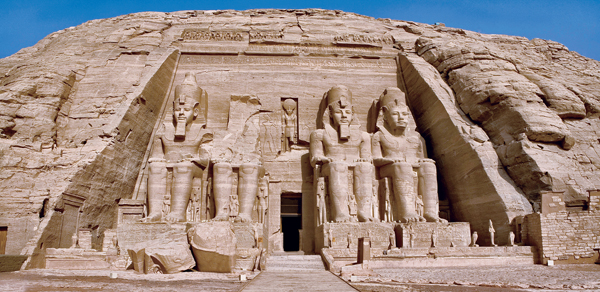
What is the location of this temple of Ramses II?
A) Gizeh
B) Amarna
C) Saqqara
D) Abu Simbel

What is the location of this temple of Ramses II?
A) Gizeh
B) Amarna
C) Saqqara
D) Abu Simbel

Unlock Deck
Unlock for access to all 50 flashcards in this deck.
Unlock Deck
k this deck
34
What three scripts appear on the Rosetta Stone?
A) Latinate, hieroglyphic, cuneiform
B) Greek, cuneiform, hieroglyphic
C) Greek, Latinate, hieroglyphic
D) Greek, demotic, hieroglyphic
A) Latinate, hieroglyphic, cuneiform
B) Greek, cuneiform, hieroglyphic
C) Greek, Latinate, hieroglyphic
D) Greek, demotic, hieroglyphic

Unlock Deck
Unlock for access to all 50 flashcards in this deck.
Unlock Deck
k this deck
35
Which Predynastic site produced early mural paintings dating to 3500-3200 BCE?
A) Saqqara
B) Hierakonpolis
C) Gizeh
D) Faiyum
A) Saqqara
B) Hierakonpolis
C) Gizeh
D) Faiyum

Unlock Deck
Unlock for access to all 50 flashcards in this deck.
Unlock Deck
k this deck
36
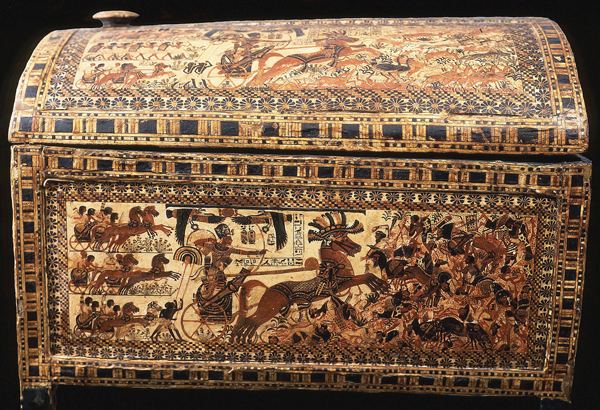
What is the findspot of this object?
A) Tomb of Tutankhamen, Saqqara
B) Tomb of Tutankhamen, Thebes
C) Tomb of Tutankhamen, Ur
D) Tomb of Tutankhamen, Amarna

What is the findspot of this object?
A) Tomb of Tutankhamen, Saqqara
B) Tomb of Tutankhamen, Thebes
C) Tomb of Tutankhamen, Ur
D) Tomb of Tutankhamen, Amarna

Unlock Deck
Unlock for access to all 50 flashcards in this deck.
Unlock Deck
k this deck
37
What is the correct term for a rectangular brick or stone tomb with sloping sides?
A) Pylon
B) Mastaba
C) Tholos
D) Ziggurat
A) Pylon
B) Mastaba
C) Tholos
D) Ziggurat

Unlock Deck
Unlock for access to all 50 flashcards in this deck.
Unlock Deck
k this deck
38
The new androgynous image of the pharaoh Akhenaton is considered by some art historians to be an attempt to make him the manifestation of what being?
A) The guardian of Nefertiti
B) The son of Horus
C) Upper and Lower Egypt united
D) The sun disk Aton
A) The guardian of Nefertiti
B) The son of Horus
C) Upper and Lower Egypt united
D) The sun disk Aton

Unlock Deck
Unlock for access to all 50 flashcards in this deck.
Unlock Deck
k this deck
39
Who was the god of order, believed to have brought civilization to the Nile?
A) Isis
B) Horus
C) Sekhmet
D) Osiris
A) Isis
B) Horus
C) Sekhmet
D) Osiris

Unlock Deck
Unlock for access to all 50 flashcards in this deck.
Unlock Deck
k this deck
40
Akhenaton moved his royal court from Thebes to which site?
A) Hierakonpolis
B) Amarna
C) Beni Hasan
D) Deir el-Bahri
A) Hierakonpolis
B) Amarna
C) Beni Hasan
D) Deir el-Bahri

Unlock Deck
Unlock for access to all 50 flashcards in this deck.
Unlock Deck
k this deck
41
The New Kingdom temple at Edfu honors which god?
A) Amen-Re
B) Osiris
C) Horus
D) Hathor
A) Amen-Re
B) Osiris
C) Horus
D) Hathor

Unlock Deck
Unlock for access to all 50 flashcards in this deck.
Unlock Deck
k this deck
42
What term describes the system of proportions used throughout the history of Egyptian art?
A) Aesthetics
B) Ben-ben
C) Canon
D) Naturalistic
A) Aesthetics
B) Ben-ben
C) Canon
D) Naturalistic

Unlock Deck
Unlock for access to all 50 flashcards in this deck.
Unlock Deck
k this deck
43
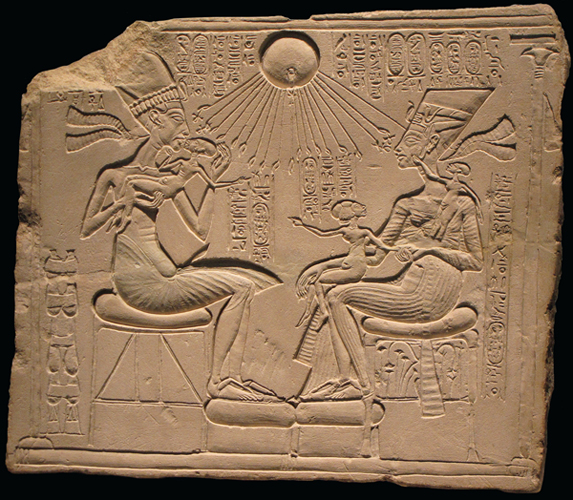
What aspect of this relief is NOT unusual in Egyptian art?
A) It shows the royal family in a domestic setting.
B) It shows the pharaoh wearing the double crown.
C) Its lines are sinuous and curving.
D) It abandons the hierarchy of scale.

What aspect of this relief is NOT unusual in Egyptian art?
A) It shows the royal family in a domestic setting.
B) It shows the pharaoh wearing the double crown.
C) Its lines are sinuous and curving.
D) It abandons the hierarchy of scale.

Unlock Deck
Unlock for access to all 50 flashcards in this deck.
Unlock Deck
k this deck
44
The frescoes from which tomb show us that New Kingdom artists did not always strictly conform to the ancient canon of representation?
A) Tomb of Ti
B) Tomb of Nebamun
C) Tomb of Amenemhet
D) Tomb 100 at Hierakonpolis
A) Tomb of Ti
B) Tomb of Nebamun
C) Tomb of Amenemhet
D) Tomb 100 at Hierakonpolis

Unlock Deck
Unlock for access to all 50 flashcards in this deck.
Unlock Deck
k this deck
45
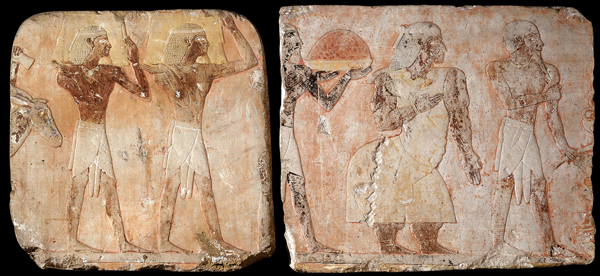
What is the subject of this painted relief?
A) It documents Ramses's conquest of the kingdom of Punt.
B) It documents Hatshepsut's successful expedition to Punt.
C) It depicts the many objects Tutankhamen will need for the afterlife.
D) It records the festival of Amen-Re at Thebes.

What is the subject of this painted relief?
A) It documents Ramses's conquest of the kingdom of Punt.
B) It documents Hatshepsut's successful expedition to Punt.
C) It depicts the many objects Tutankhamen will need for the afterlife.
D) It records the festival of Amen-Re at Thebes.

Unlock Deck
Unlock for access to all 50 flashcards in this deck.
Unlock Deck
k this deck
46
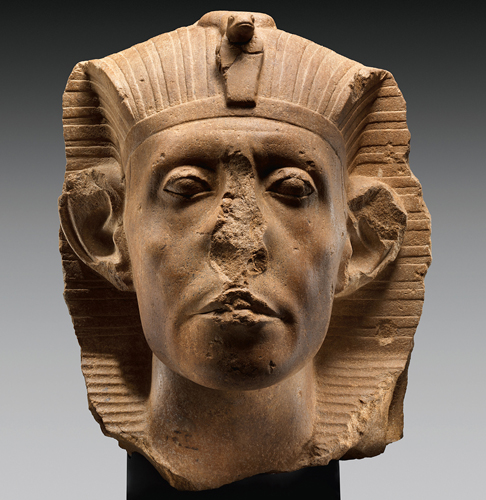
The slightly pessimistic expression of this figure is an indication that it was made during which period?
A) Old Kingdom
B) New Kingdom
C) Middle Kingdom
D) Early Dynastic

The slightly pessimistic expression of this figure is an indication that it was made during which period?
A) Old Kingdom
B) New Kingdom
C) Middle Kingdom
D) Early Dynastic

Unlock Deck
Unlock for access to all 50 flashcards in this deck.
Unlock Deck
k this deck
47
Which site provides information about Middle Kingdom burial practices?
A) Hierakonpolis
B) Saqqara
C) Beni Hasan
D) Gizeh
A) Hierakonpolis
B) Saqqara
C) Beni Hasan
D) Gizeh

Unlock Deck
Unlock for access to all 50 flashcards in this deck.
Unlock Deck
k this deck
48
What New Kingdom sculptural form is embodied by the statue of Senenmut and Nefrura?
A) Seated statue
B) Stylized embrace
C) Block statue
D) Idealized features
A) Seated statue
B) Stylized embrace
C) Block statue
D) Idealized features

Unlock Deck
Unlock for access to all 50 flashcards in this deck.
Unlock Deck
k this deck
49
Which structure is not a part of the complex at Gizeh?
A) Mastaba
B) Sphinx
C) Pyramid of Menkaure
D) Stepped pyramid
A) Mastaba
B) Sphinx
C) Pyramid of Menkaure
D) Stepped pyramid

Unlock Deck
Unlock for access to all 50 flashcards in this deck.
Unlock Deck
k this deck
50

What is the name of the subject of this portrait?
A) Menkaure
B) Mentuemhet
C) Ramses II
D) Amenhotep

What is the name of the subject of this portrait?
A) Menkaure
B) Mentuemhet
C) Ramses II
D) Amenhotep

Unlock Deck
Unlock for access to all 50 flashcards in this deck.
Unlock Deck
k this deck



